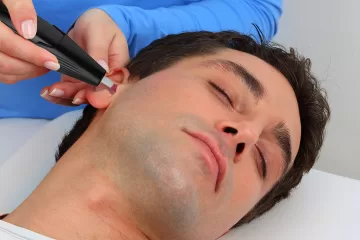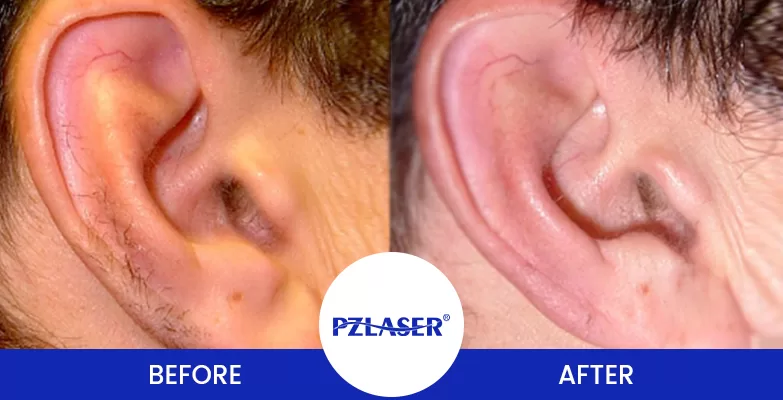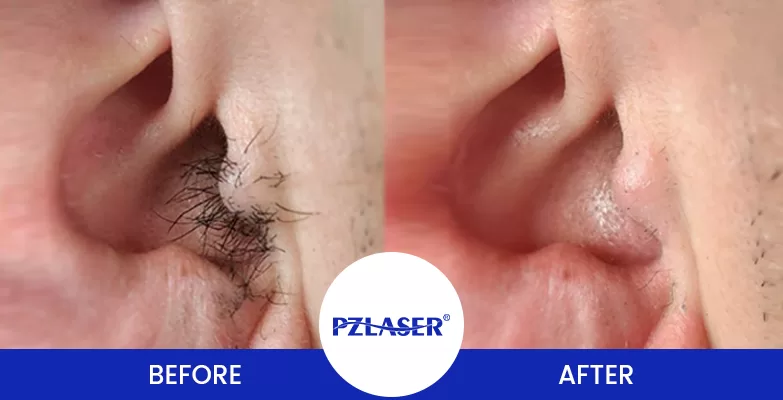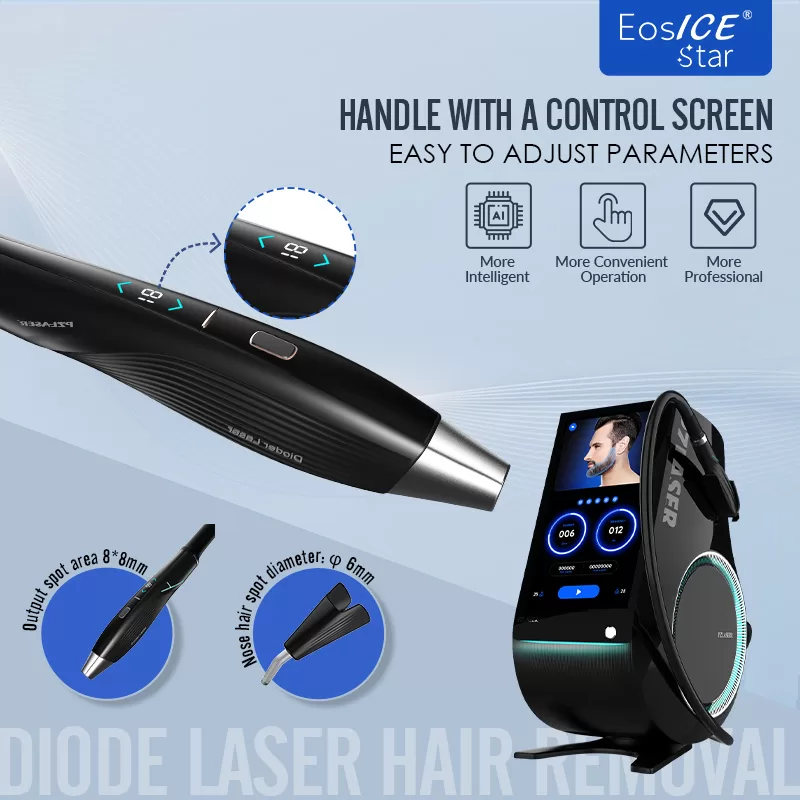
Introduction
Everyone has hairs on their ears as they protect themselves by preventing dust and debris from entering the ear canal. However, excessive ear hair can be aesthetically unpleasing and cause hygiene concerns. Many individuals seek ways to do ear hair removal permanently and naturally for a cleaner and more polished look.
This guide explores various hair removal methods, from traditional trimming to laser ear hair removal, highlighting natural and permanent solutions. If you're looking for the best way to remove ear hair, this article will help you choose the most effective method.
Understanding Ear Hair Growth
What is Ear Hair?
Ear hair grows in and around the ear canal and outer ear, serving as a natural barrier against external irritants. Deep inside your ear, tiny hairs help you hear and maintain balance. However, excessive or coarse hair can be bothersome and require regular maintenance.
Why Does Ear Hair Grow?
Before you were born, your body, including your ears, was covered in fine, soft hair. As you age, the hair around your ears tends to become more abundant—particularly in men. Medical professionals believe this phenomenon may be linked to increased testosterone levels. This hormone not only thickens and coarsens the hair but can also contribute to its graying over time.
What Causes Extra External Ear Hair?
Understanding the root cause of your unwanted hair can help in choosing the most effective hair removal treatments. There are several factors contribute to ear hair growth:
Genetic Factors
Genetics plays a significant role in how much hair from the root grows in your ears. If your family members have noticeable outer ear hair, you are more likely to experience the same.
Hormonal Changes
Fluctuations in hormones, especially testosterone, lead to increased hair thickness. Men tend to develop more prominent ear hair after middle age due to these hormonal influences.
Aging Process
As hair follicles age, they become more sensitive to androgens, causing excessive hair growth in unusual areas like the ears and nose.
Medical Conditions
Though rare, conditions such as hypertrichosis or hormonal imbalances may result in excessive ear hair growth, requiring medical evaluation.
How to Remove Ear Hair Permanently?
There are several hair removal methods available, from temporary fixes to permanent ear hair removal solutions.
Temporary Methods
- Trimming: Using an ear hair remover, such as electric trimmers, is quick but requires regular maintenance.
- Waxing: Ear hair removal wax removes hair from the root, keeping the skin smooth for weeks. However, waxing can be painful and risky due to the sensitive nature of the ear canal.
- Depilatory Creams: Chemical solutions dissolve hair but must be used cautiously to avoid irritation.
Permanent Solutions
Laser Ear Hair Removal:

The laser targets hair follicles using light energy, preventing regrowth. It requires multiple sessions but offers long-term reduction. So it's safe, effective, and widely recommended among us.
Electrolysis:

Electrolysis uses electric currents to destroy hair follicles at the root, making it a suitable option for individuals seeking complete and permanent ear hair removal. However, it is generally more time-consuming and can be more painful compared to laser treatment for ear hair removal.
Natural Remedies
While natural treatments exist, they lack scientific backing for permanent results. Some DIY solutions include:
- Turmeric Paste: May slow hair growth when applied consistently.
- Sugar Wax: A gentler alternative to traditional hot wax.
- Papaya Mask: Contains enzymes that weaken hair follicles over time.
EosICE® Star: The Best Laser Solution for Ear Hair Removal

The EosICE® Star laser hair removal machine is a cutting-edge solution for laser ear hair removal, combining advanced diode laser technology with a built-in cooling system to deliver unparalleled precision, safety, and comfort. Specifically designed for delicate areas like the ears, it targets hair follicles effectively without damaging surrounding tissue, ensuring a virtually painless and non-invasive experience. Safe for all skin types, the EosICE® Star offers long-lasting results with minimal downtime, reducing unwanted hair in just a few quick sessions. Unlike traditional ear hair removal methods, EosICE® Star offers a permanent ear hair removal solution, eliminating the need for constant maintenance.
Main Steps for Laser Ear Hair Removal
Laser ear hair removal is a precise and effective procedure designed to provide long-term results. To ensure safety and effectiveness, it's crucial to follow a structured process. Here’s a step-by-step guide to what you can expect during laser ear hair removal:
Consultation
The first step is to consult a certified laser specialist or dermatologist. During this visit, the professional will assess your skin type, hair color, and hair density to determine if laser treatment is the best option for you. Since laser hair removal works best on dark, coarse hair, individuals with lighter or fine hair may not experience the same level of effectiveness.
Additionally, your medical history will be reviewed to rule out any conditions or medications that may interfere with the treatment. A patch test may also be performed to assess how your skin reacts to the laser.
Preparation
Proper preparation is essential to maximize the success of your laser hair removal treatment. Here’s what you need to do before your session:
- Avoid sun exposure for at least two weeks before treatment, as tanned or sunburned skin can increase the risk of burns or pigmentation issues.
- Refrain from waxing, plucking, or using depilatory creams for at least four weeks prior. These methods remove hair from the root, which is necessary for the laser to effectively target the follicle.
- Shave the area 24 hours before your session. Shaving ensures that the laser energy is focused on the hair follicle beneath the skin rather than the hair above the surface.
- Keep your ears clean and dry before the appointment to prevent irritation.
Procedure
Once you’re prepped and ready, the actual laser hair removal process begins. Here’s what happens during the procedure:
- You will be provided with protective eyewear to shield your eyes from the laser light.
- A cooling gel or numbing cream may be applied to reduce discomfort.
- The specialist will use a precision laser device to target unwanted hair inside and around the outer ear. The laser emits a highly concentrated beam of light that penetrates the hair follicle, disabling its ability to grow.
- You may feel a mild tingling or warm sensation, often compared to the snap of a rubber band against the skin.
- The session usually takes 5-15 minutes, depending on the amount of hair being treated.
The EosICE® Star laser hair removal system is an excellent choice for this procedure, as it is designed to provide painless, quick, and effective results with advanced cooling technology to minimize discomfort.
Aftercare
Post-treatment care is crucial to prevent irritation and enhance results. Follow these aftercare steps:
- Apply a soothing cream or aloe vera to calm any redness or sensitivity.
- Avoid direct sunlight and always use SPF 30+ sunscreen if you need to be outdoors.
- Do not scratch, rub, or expose the treated area to excessive heat, including saunas and hot showers, for at least 48 hours.
- Refrain from using harsh skincare products on the treated area to prevent irritation.
Most patients experience only mild redness, which subsides within a few hours.
Follow-Up Sessions
Laser hair removal is not a one-time treatment; multiple sessions are required to achieve permanent hair reduction. Since hair grows in different cycles, each session targets a new set of actively growing follicles.
- Typically, 4-6 sessions spaced 4-6 weeks apart are needed for the best results.
- Over time, hair regrowth becomes thinner and less noticeable until it eventually stops.
- Annual maintenance sessions may be necessary for some individuals, depending on their hair growth patterns.
By following these steps and choosing a professional laser system like EosICE® Star, you can achieve a smooth, hair-free look with minimal effort and maximum results.
FAQs about Ear Hair Removal
Is ear hair removal safe?
Yes, when performed correctly using professional hair removal treatments.
Can ear hair grow back after laser removal?
Laser significantly reduces regrowth, but occasional maintenance may be needed.
What is the best method for sensitive skin?
Laser treatment for ear hair removal is the safest for sensitive areas.
How much does permanent ear hair removal cost?
Prices vary but expect $100-$300 per session for laser treatments.
Are there any side effects of laser ear hair removal?
Mild redness or sensitivity may occur but typically subsides within hours.
Conclusion
Managing ear hair is essential for both aesthetics and hygiene. While trimming and waxing offer temporary fixes, laser ear hair removal provides a permanent and natural solution. The EosICE® Star diode laser stands out as the best ear hair removal option, ensuring safe and long-lasting results for those with hairy ears or who want to remove unwanted hairs on their ears.






